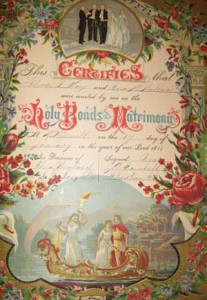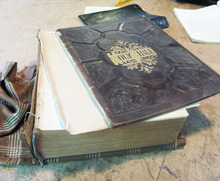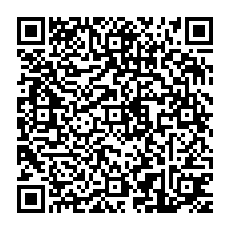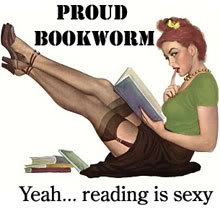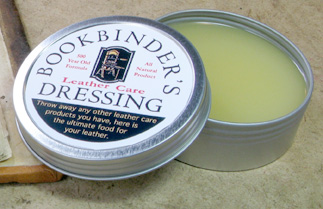 The Family Bible is typically 12 x10 by 4 inches. The Bible was most likely published between 1840 and 1900. In the beginning of this Family Bible period the covers were flat with little embossment if any. Later Family Bibles from 1870 are most often deeply embossed and have panels stamped in gold. More often than not the later Bibles’ paper can be more embrittled than earlier Bibles. Paper was mass-produced with more harsh chemicals after the beginning of the industrial revolution. Earlier Bibles tend to be single columned content where newer ones of the late Victorian will be double columned. These later Bibles often have glossaries, maps and illustrated sections in the front of the Bible.
The Family Bible is typically 12 x10 by 4 inches. The Bible was most likely published between 1840 and 1900. In the beginning of this Family Bible period the covers were flat with little embossment if any. Later Family Bibles from 1870 are most often deeply embossed and have panels stamped in gold. More often than not the later Bibles’ paper can be more embrittled than earlier Bibles. Paper was mass-produced with more harsh chemicals after the beginning of the industrial revolution. Earlier Bibles tend to be single columned content where newer ones of the late Victorian will be double columned. These later Bibles often have glossaries, maps and illustrated sections in the front of the Bible.
Why is this family relic in poor condition? Family Bibles like everything else suffer the passage of time, but the biggest threats to the Bible are heat, humidity and light. That is not to say that some of these venerable giants have simply been worn-out by use. There are usually many forensic signs of heavy usage such as, food and debris in the gutters, ear-marked pages from heavy use, hair braids to corsages stuffed between pages, torn and bumped covers and finally the general rubs and abrasions of prolonged use. But suffering all this, again a Bible’s great enemies are heat, humidity and light.
The effects of these three conditions do more to age and breakdown the substance of Bibles than anything else. From what materials are a Bible made? First, the papers in earlier Bibles are a cotton, linen or a mix of the two. These fibers are very long lived and as an example a pure linen paper can easily last over 500 years. Later, the pages were pulped using tree fibers and harsh chemicals. That’s why I said older paper is likely to be in better condition because of the quality of materials. Older Bibles may have one or two different papers, typically one kind for illustrations and the other for text. Later Bibles have a change of papers like a model in a fashion show. For example the illustrations, the title page and interleafing tissue, the text paper, the Family Record pages, more text paper and at the back heavy paper lined board where photographs are inserted.
Family Bibles are made with leather. Again owing to radical changes in the production techniques, earlier Bibles tend to have longer lasting leather and newer ones can become powdery and tattered. For the most part all Bibles were covered in calf. There are examples of cloth bindings for Bibles, too. These were the poor families’ option. In late Victorian clothbound Bibles there is a likelihood of poor paper, too.
Hide glue was used to along with linen thread to bind the Bibles. Hide glue is only good for about a hundred years before it becomes brittle. Hide glue also can be acidic. It is not unusual to see the spine of the Bible parting from the glue having shrunk and separated from the paper. Because of the shear weight of the Family Bible, all these materials bound together properly can last for centuries, if one fails the whole Bible will soon fall apart.
With the ingredients of leather, cotton, hide glue and linen we see in its composition that this is a rather organic system. In some ways it is miraculous they don’t get eaten by vermin and pets! Take any of these materials and nail them to an outside post and you’ll witness a rather quick degradation to dust! So then, what can we do to prolong these precious heirlooms?
- Never put a Bible in the basement, garage or attic.
- Never put a Bible upright without lateral support.
- Never leave a Bible opened for prolonged periods.
- Never let sunlight or harsh lighting contact the Bible
- Never keep a Bible in either a humid or extremely dry environment.
- Never keep a Bible in an extremely warm environment.
- Do keep a Bible at room temperature 68 to 72 degrees.
- Do store a Bible flat but make sure it’s kept to its form not canted.
- Do maintain humidity as close to 50% as possible.
- Do contain the Bible in an archival box.
- Do store the Bible near bottom of the closet. (Not the floor (flood) not on top (fire))
- Do keep the Bible Record updated with a note inside front cover with family names.
- Do choose a responsible guardian to transfer the Bible when you are ready.
Nothing lasts forever, at least in a physical form. Family Bibles after 100 years generally can use the services of a professional bookbinder. With the proper restoration and conservation, this heirloom can reasonably last another 100 years. Use caution in selecting a good conservator and your family will enjoy and treasure your Family Bible for many more generations.
Clicking FaceBook, Twitter or other icons promotes the article and my work.
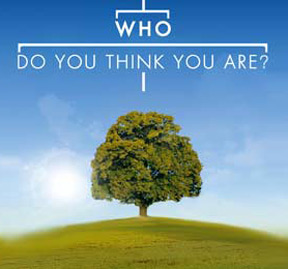 The second season of NBC’s Who Do You Think You Are? will air at 7 p.m. Feb. 4. The genealogy series is a clone several other countries have adapted which include Canada, Australia, Ireland, South Africa, Israel, Sweden and Norway. The first show kicks off with Vanessa Williams.
The second season of NBC’s Who Do You Think You Are? will air at 7 p.m. Feb. 4. The genealogy series is a clone several other countries have adapted which include Canada, Australia, Ireland, South Africa, Israel, Sweden and Norway. The first show kicks off with Vanessa Williams.
 Facebook
Facebook Twitter
Twitter Digg
Digg StumbleUpon
StumbleUpon del.icio.us
del.icio.us Add to favorites
Add to favorites

